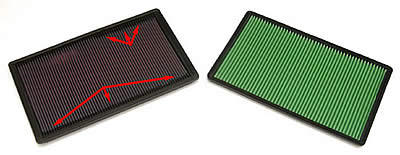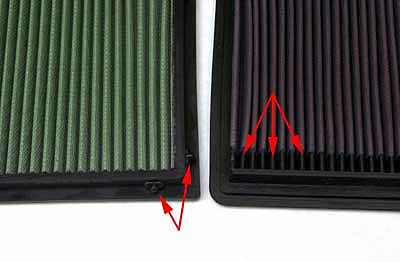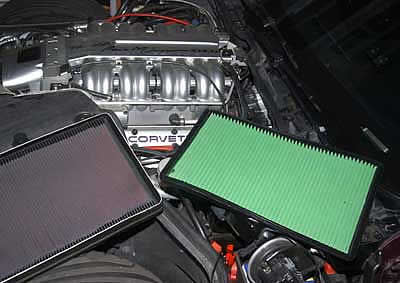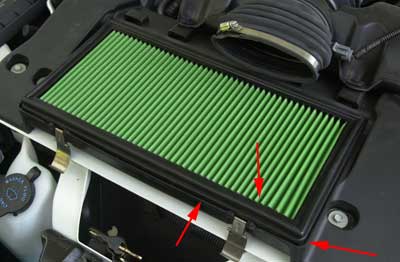Air filters which use cotton as their filter media have been around for a generation. Pioneered by K&N Engineering over 30 years ago, this type of filter has become popular amongst Corvette enthusiasts because of its low restriction to air flow. For many years, virtually the sole source for these filters was the originator, K&N Engineering. Yeah, there were a few foreign-sourced, knock-offs available, but for a long time, K&N had the lion’s share of the market in North America to itself.
In the late-’90s, the competitive situation in the cotton filter market began to change. Other aftermarket companies, observing the success K&N Engineering enjoyed with its “Filtercharger” but noticing its core design (cotton gauze inside aluminum mesh attached to a molded rubber structure) hadn’t changed in a couple of decades, introduced similar products, some of which used updated designs. Today, in addition to K&N Engineering, Mr. Gasket sells cotton filters under its “Accel Kool Blue” brand, Airaid makes them, Green Filter has its version of this product and there are a few others.
I’ve used K&N Filters for nearly 20 years in my Corvettes and other cars. About a year ago, I was running my ’01 Camaro on K&N’s chassis dyno, testing one of its Filtercharger replacement filters. I was surprised to find that filter responsible for a small performance loss compared to the stock, ACDelco paper filter element. This seemed unusual to me because: 1) the testing was on K&N’s own dyno, 2) I ran the test more than once to confirm the results and 3) it was the first time in nearly 20 years I saw a performance loss after swapping a stock filter for a K&N.
It struck me that this particular Filtercharger might have been defective, so I asked the K&N folks for a second filter and some more chassis dyno time to retest it. Unfortunately, they were unwilling to fulfill my requests. At that point, speculating that K&N’s reluctance towards more testing suggested a problem with the filter design for the particular vehicle I was using and not a single instance of a defective product; I returned the filter to K&N, thanked them for the dyno time and investigated other options in high-performance air filters. That led me to the Green Filter.

Side by side comparison of the panel filter for 90-96 C4. Right is K&N. Left is Green Filter. The white arrows point to the areas of the K&N where rubber has flowed out onto the filter surface.Image: Author.

The arrows point at the trimmable “nubs” on the green filter (left) and point to the rubber spill-over problem the K&N (right) has. Image: Author.
Green Filter is unknown to many automotive enthusiasts in the U.S. but, over in Europe, it’s a huge name, especially in motorsports. In fact, according to Green Filter USA spokesperson, Jason Early, the brand has an astonishing, 85% penetration in the oiled-cotton filter market in Europe. The company was formed in 1995 with the intent of supplying premium, cotton air filters to the racing industry. The product has been used successfully by Peugeot Sport (World Rally Champions), ORECA (they raced Vipers in endurance road racing in the late 90s) along with other notable European race teams. Realizing the profit potential in the street high-performance market, it wasn’t long before Green Filter began to make filters for street cars. In late 2001, the Green folks began to market their products in the U.S. Green Filters are manufactured in France, the United Kingdom and at the company’s American facility in Braddock, Pennsylvania. Green has filters for most Corvettes from the mid-’60s to ’04 with the only exception I can find being the ’82 and ’84 L83 Crossfire Injection engines.
 There are several differences between a K&N Filtercharger and a Green Filter. I noted some of them the first time I put a K&N and a Green side-by-side on my work bench. The first is color. K&Ns are red. Green Filters are, well…green. No big deal. It’s just the difference in the dye used in each company’s filter oil.
There are several differences between a K&N Filtercharger and a Green Filter. I noted some of them the first time I put a K&N and a Green side-by-side on my work bench. The first is color. K&Ns are red. Green Filters are, well…green. No big deal. It’s just the difference in the dye used in each company’s filter oil.
A more functional difference is how a Green Filter’s rubber “seals” (the pliable structure around the edges of a panel filter or on the ends of a round filter) are designed. Most K&N have a simple, injection-molded seal. Hot rubber is injected into a mold holding the filter media. It hardens, then the mold is opened and the part removed. This basic injection molding process is easy and cheap, but some rubber flows onto the filter surface, decreasing available filter area. While you can easily see this difference between the K&N and the Green for a late C4, it’s not a big issue because of the huge size of this filter. With smaller filters, such as the units for 1985 – 1989 Corvette C4 or C5, or filters even smaller than that, a 1/4 inch or so of rubber “spill-over” can make a difference. With a filter that is, say 4×5-inches, filter area decreases by 25%. Green Filter’s more costly process prevents rubber leakage onto the filter media. No practical surface area is wasted and air flow capability is higher, compared to a K&N for the same application.
Another advantage Green Filter has over K&N is that the edges of most Green Filters have “trimmable nubs” molded into the rubber seal to better fit the filter to a wider variety of filter housings. Some air boxes are made of thin plastic that may change shape slightly due to underhood heat. The nubs help Green Filters fit “warped” air boxes. If you have a tight filter mounting, you can trim some of the nubs. If you have an air box that’s loose-fitting, leave the nubs as-is. I think trimmable nubs are a darn smart idea.
When comparing other cotton filters to Green, in some cases, you’ll note a difference in filter media pleats. Green Filters are pleated parallel to the filter’s width. Compared to a filter pleated perpendicular to its length, a Green Filter is more rigid. In some cases this additional rigidity prevents air leaks around the seal caused by the filter flexing due to air flow through it. Another parallel-pleat benefit, compared to a filter with perpendicular pleats, is more pleats results in more filter area.
Probably the most important benefit of a Green Filter over a K&N is not obvious unless you examine the filter media closely. Depending on the application, a K&N has between four and six layers of cotton gauze. Green Filter uses two layers of woven cotton. The difference is significant. Gauze is a good material for a filter, but is somewhat fragile. Areas of reduced thickness or, in extreme cases, even holes can wear in the gauze. The structure of woven cotton is like that of the material of which golf or polo shirts are made. The advantages to woven cotton rather than gauze are: 1) it’s thinner but still maintains good filtration. 2) It holds oil more uniformly. 3) It is a lot stronger than a gauze. You can wear a hole in gauze bandage just by rubbing it. You can’t do that with a shirt.
It’s not easy to find information about automotive air filter efficiency or standards. Few air filter manufacturers publicly discuss how well their products work. I wonder about that, especially considering how much stuff you find on the Internet about oil filters. What data is available seems to indicate that particles between 10 and 20 microns in size are responsible for most engine wear resulting from abrasive contaminants in the intake charge air. Where the Green Filter–and the K&N for that matter–excel is filtering particles in the 10-20 micron range. In fact, Green folks claim their product can filter particles as small as 5 microns. As far as efficiency, oiled-cotton filters commonly demonstrate filtering efficiencies in the 10-20 micron range of 96-98% and sometimes it can be as high as 99%. Those kinds of filtration efficiency numbers along with the high airflow a Green Filter can sustain is proof that the oil-impregnated cotton filtering idea works pretty well.
There is a big difference in how paper and oiled-cotton filters work. Paper filters pass particles smaller than the “holes” in the filter material and trap the particles too large to go through the holes. When you think about this a little more, you see why paper filters tend to be restrictive. The holes in the paper have to be really tiny to filter tiny particles. When the holes are really tiny, they pose a restriction to air flow.
Oiled-cotton filters do not work as above. They remove contaminants through a different process–actually three different processes: diffusion, impaction and interception. “Diffusion” traps the smallest particles, many of which are in the damaging, 10-20 micron range. These particles are affected by the forces at work in the intake charge air stream. Changes in velocity and pressure, turbulence and interaction with other molecules cause the motion of these tiny particles to become irregular and frenzied. Once that happens, they don’t follow the flow. Their chaotic activity has them running into fibers then being retained by the oil. This phenomenon enables the filter to catch particles that are much smaller than the openings in the media. “Impaction” occurs when the mass of a particle is so large it is unable to follow curving air flow. Massive particles “drop out” of the air flow, hit the fibers and are retained by the oil. “Interception” applies to “medium-weight” particles traveling with the charge air. As air flows near the fibers, the particles in that air contact the fibers and are captured by the oil on the fibers.
A paper filter traps contaminants only on the surface of the paper. Cotton filters work differently. The layers of cotton fiber catch contaminants, not only on the surface of the media, but throughout its thickness. As a result, cotton filters hold more contamination for a given area than can a typical paper filter. This is why oiled-cotton filters offer low restriction and good filtering and the Green Filter is one of the best.

My LT5 engine at the time of filter change. It was a straight-across swap. The new Green Filter fit my stock air filter housing perfectly. Image: Author.
I’ve been testing Green Filters on two different cars since the fall of 2002. One of them is a 1995 Corvette ZR-1. Admittedly, at the power level of my engine (about 500hp) there is no performance advantage to the Green Filter over a new, stock paper filter because of the filter area. The stock paper filter used on 1989 – 1996 Corvettes will provide enough air flow for about 600 hp. This is why, when I ran a dyno test comparing the engine with no filter assembly at all to a oiled-cotton filter in a stock filter housing with an open-element DRM air filter top, there was no difference in performance. That situation changes as the filters trap dirt. Because of the different way oil-cotton filters work, they are capable of higher air flow for a given level of contamination than is a paper filter. So, in this case, with a filter as large as the panel filter used on a ZR-1, there’s no difference when the filters are new, but after some time in service, the paper filter’s ability to flow air decreases quite rapidly whereas the oiled-cotton filter can trap the same level of contamination and not restrict.

Here’s the Green Filter for a Chevy Camaro. It’s size is also close to what is used on a C5. Note how precisely the unit fits the filter housing. Also, again note, there’s no rubber spill-over. The entire filter surface is available for air flow. Image: Author.
The main advantage to the Green Filter on an 1984 – 1996 Corvette is that the filter is reusable. Once it becomes dirty, simply remove the filter and, using Green Filter’s “Air Filter Cleaner” (a specific type of detergent), clean the filter according to the directions on the container. Dry the filter, then re-oil it using Green Filter’s “Air Filter Oil”, again, following the instructions on the container. The great thing about a Green Filter is you can do this over-and-over again. Barring physical damage, a Green Filter should last the life of the vehicle. When you check the cost of a new paper filter and know you need to replace it every 15,000 miles or so, you see the value of the Green Filter quite clearly.
As for how the Green Filter works in my Camaro? Well…as K&N kind of “booted” me off their dyno, I never was able to run any more chassis dyno tests, however, I’ve run the Green Filter in that car for a number of months. My subjective evaluation is that I detected a slight improvement in the engine’s performance at high rpm when I replaced the original paper filter (which I reinstalled and ran for several months after I returned the test item to K&N) with the Green Filter.
If there’s anything that can be said against the Green Filter, it’s that, compared to K&N, its distribution in the U.S. is limited and, if you want to purchase the filter cleaner and oil separately, you usually need to special order it. Those two problems will gradually become less an issue as Green Filters become more widely available.
In the end, what I like best is this filter can be cleaned and reused. I also like the more elegant method of manufacture the Green folks use. Not only does it result in a small increase in usable filter area but it makes the surfaces of a Green Filter look like they are properly finished. For more information on the Green Filter, visit the Green Filter web site at greenfilter.com/

